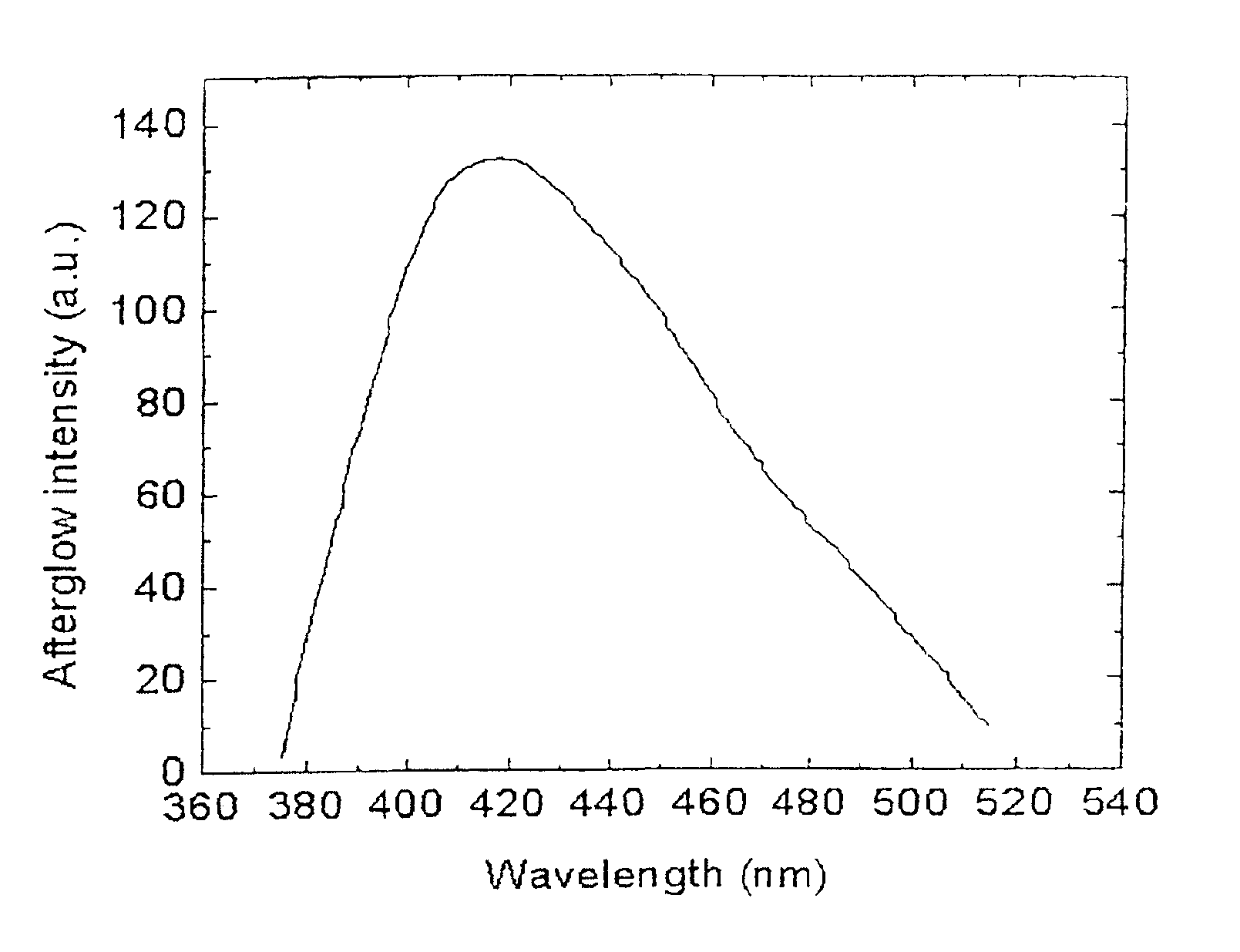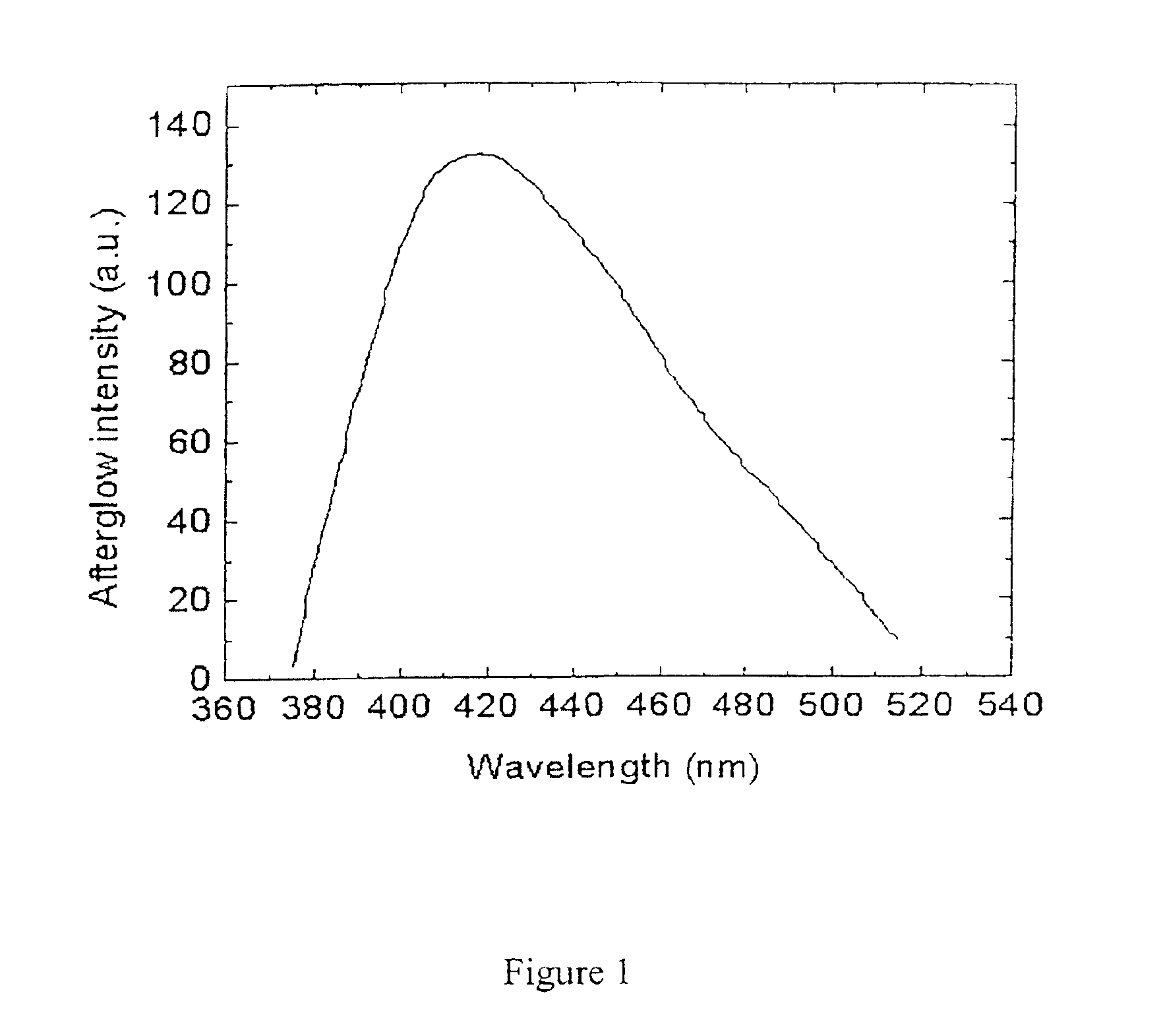Long persistent phosphors and persistent energy transfer technique
a technology of persistent phosphors and energy transfer techniques, applied in the direction of luminescent compositions, polycrystalline material growth, crystal growth processes, etc., can solve the problems of not being conducive to many applications, and achieve the effect of long-lasting phosphorescen
- Summary
- Abstract
- Description
- Claims
- Application Information
AI Technical Summary
Benefits of technology
Problems solved by technology
Method used
Image
Examples
example 1
Preparation of Single Crystal CaAl2O4:Ce 3+
[0077]The phosphor components were combined in the following proportions:
1.01667CaCO3+Al2O3+0.5% Ce2(CO3)3
[0078]The purity of the starting materials was 99.95% for alkaline earth oxides and other compounds, 99.95% for aluminum oxide, and 99.9% for rare earth oxides and other compounds.
[0079]The mole ratio of calcium, aluminum, oxygen and cerium in the compound is
Ca2+:Al3+:O2−:Ce3+=1.01667:2:4:0.01.
[0080]The mixture of the raw materials was pressed into pellets with 1.5 mm thickness and 15 mm diameter. The pellets were first sintered at 900° C. for 2 hours in air. The sintered mixture was ground, mixed, and pressed into pellets again. The pellets were then sintered at 1350° C. for 5 hours in air. The sintered pellets were then cut into 1×1 mm2 rods with sharp tips at one end to serve as feeds and seeds. The single crystal fibers were pulled using the LHPG method with 1 mm / min seed speed and 0.3 mm / min feed speed in a chamber with 5% H2+N2 ...
example 2
Preparation of SrAl2O4:Ce3+
[0083]The phosphor components were combined in the following proportions.
SrCO3+Al2O3+0.5% Ce2(CO3)3+1% B2O3(flux)
[0084]The purity of the starting materials was 99.95% for alkaline earth oxides and other compounds, 99.95% for aluminum oxide, and 99.9% for rare earth oxides and other compounds, and 99.9% for boron oxide or boric acid.
[0085]The mole ratio of strontium, aluminum, oxygen and cerium in the compound is:
Sr2+:Al3+:O2−:Ce3+=1:2:4:0.01.
[0086]The mixture of the raw materials was pressed into pellets with 1.5 mm thickness and 15 mm diameter. The pellets were first sintered at 900° C. for 2 hours in air. The sintered mixture was ground, mixed, and pressed into pellets again. The pellets were then sintered at 1350° C. for 5 hours in 5% H2+N2 gas flow to prevent oxidation of Ce3+ to Ce4+.
[0087]FIG. 3 shows the afterglow spectrum for this material. The afterglow curve peaks at 395 nm (deep blue). FIG. 4 shows the afterglow decay curve for this material, ...
example 3
Preparation of Single Crystal CaAl2O4:Ce3+, Tb3+
[0088]The phosphor components were combined in the following proportions:
1.01667CaCO3+Al2O3+0.5% Ce2(CO3)3+0.5% Tb2O3
[0089]The purity of the starting materials was 99.95% for alkaline earth oxides and other compounds, 99.95% for aluminum oxide, and 99.9% for rare earth oxides and other compounds.
[0090]The mole ratio of calcium, aluminum, oxygen, cerium, and terbium in the compound is
Ca2+:Al3+:2−:Ce3+:Tb3+=1.01667:2:4:0.01:0.01.
The mixture of the raw materials was pressed into pellets with 1.5 mm thickness and 15 mm diameter. The pellets were first sintered at 900° C. for 2 hours in air. The sintered mixture was ground, mixed, and pressed into pellets again. The pellets were then sintered at 1350° C. for 5 hours in air. The sintered pellets were then cut into 1×1 mm2 rods with sharp tips at one end to serve as feeds and seeds. The single crystal fibers were pulled using the LHPG method with 1 mm / min seed speed and 0.3 mm / min feed spee...
PUM
| Property | Measurement | Unit |
|---|---|---|
| peak emission wavelength | aaaaa | aaaaa |
| emission peaks | aaaaa | aaaaa |
| emission peaks | aaaaa | aaaaa |
Abstract
Description
Claims
Application Information
 Login to View More
Login to View More - R&D
- Intellectual Property
- Life Sciences
- Materials
- Tech Scout
- Unparalleled Data Quality
- Higher Quality Content
- 60% Fewer Hallucinations
Browse by: Latest US Patents, China's latest patents, Technical Efficacy Thesaurus, Application Domain, Technology Topic, Popular Technical Reports.
© 2025 PatSnap. All rights reserved.Legal|Privacy policy|Modern Slavery Act Transparency Statement|Sitemap|About US| Contact US: help@patsnap.com



